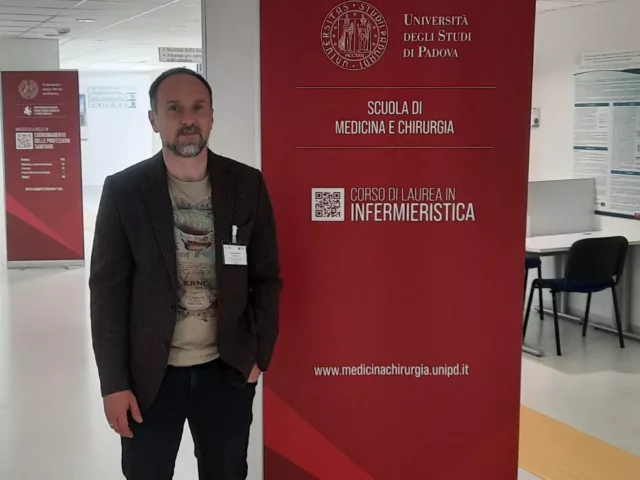
W dniach 6-10.05.2024 pracownik PANS (dr hab. Paweł Więch, prof. PANS) zrealizował mobilność dydaktyczną w ramach programu Erasmus+ na Uniwersytecie w Padwie (Włochy).
Uniwersytet w Padwie, jeden z najstarszych i najbardziej prestiżowych uniwersytetów we Włoszech, ma bogatą historię sięgającą 1222 roku. Uniwersytet jest znany z wkładu w badania naukowe w dziedzinach takich jak medycyna, astronomia, filozofia i prawo. Znajduje się tu najstarszy zachowany stały teatr anatomiczny w Europie.
Przez wieki studiowało tam wiele wybitnych postaci, które miały znaczący wpływ na rozwój nauki, kultury i polityki. Między innymi: Galileo Galilei (słynny astronom, fizyk i matematyk, który prowadził wykłady w latach 1592-1610; to tutaj rozwijał swoje teorie dotyczące ruchu i mechaniki), Nicolaus Copernicus (Mikołaj Kopernik – polski astronom, który studiował prawo kanoniczne w latach 1501-1503; jego rewolucyjna teoria heliocentryczna zmieniła postrzeganie wszechświata), Andreas Vesalius (flamandzki anatom, który w połowie XVI wieku studiował i nauczał na Uniwersytecie w Padwie; jest uznawany za ojca nowoczesnej anatomii) czy William Harvey – angielski lekarz, znany z odkrycia systemu krążenia krwi i funkcji serca. Studiowała tu także Elena Cornaro Piscopia – pierwsza kobieta, która uzyskała doktorat (Ph.D.) w filozofii w 1678 roku.
Obecnie Uniwersytet w Padwie składa się z 32 wydziałów, które są zgrupowane w osiem szkół: Nauk Rolniczych i Medycyny Weterynaryjnej, Ekonomii i Nauk Politycznych, Inżynierii, Nauk Humanistycznych i Społecznych oraz Dziedzictwa Kulturowego, Prawa, Medycyny, Psychologii oraz Nauk Ścisłych. Taka struktura wspiera szeroki zakres dyscyplin akademickich i sprzyja interdyscyplinarnym badaniom
i edukacji.
Uniwersytet w Padwie oferuje różnorodne programy studiów prowadzone w języku angielskim, które są skierowane do studentów zagranicznych. Obejmują one zarówno studia licencjackie, jak
i magisterskie w różnych dziedzinach, takich jak inżynieria, ekonomia, medycyna i inne. Padwa aktywnie uczestniczy w programie Erasmus+ i utrzymuje dwustronne umowy z uniwersytetami na całym świecie, co ułatwia wymianę studentów i wzbogaca ich doświadczenie globalne. Uniwersytet zapewnia kompleksowe i wspierające środowisko dla studentów zagranicznych, łącząc solidne podstawy akademickie z szerokim zakresem usług wsparcia, aby zapewnić satysfakcjonujące doświadczenie edukacyjne w jednej z najstarszych i najbardziej szanowanych instytucji we Włoszech.
W ramach wyjazdu przedstawiono główna bazę medyczną powiązaną z Uniwersytetem – szpital
w Monselice oraz Centrum Symulacji. Placówka oferuje szeroki zakres usług medycznych, w tym opiekę ratunkową oraz podstawowe i specjalistyczne leczenie. Placówka jest znana z dobrze zorganizowanego personelu i odpowiedniego wyposażenia medycznego. Uwieńczeniem wizyty była możliwość zobaczenia „w akcji” systemu chirurgicznego „da Vinci” – zaawansowanego urządzenia robotycznego, które wspomaga chirurgów w wykonywaniu małoinwazyjnych operacji. System ten jest wykorzystywany w różnych rodzajach operacji, w tym urologicznych, ginekologicznych, kardiochirurgicznych oraz ogólnych.
Ostatnim akcentem wizyty (10 maja 2024) było czynne uczestnictwo w konferencji naukowej poświęconej tematyce przyszłości i rozwoju w Pielęgniarstwie. Prelegent wystąpił z tematem “Virtual reality in the education of nursing staff”. Zakłada się, że nawiązane znajomości zaowocują przyszłymi wspólnymi projektami dydaktycznymi i naukowymi. Szczególne podziękowania dla dr Matteo Danielis oraz dr Matteo Simioni.
ENG.
From May 6 to 10, 2024, a PANS employee (Dr. habil. Paweł Więch, Prof. PANS) conducted a teaching mobility as part of the Erasmus+ program at the University of Padua (Italy).
The University of Padua, one of the oldest and most prestigious universities in Italy, has a rich history dating back to 1222. The university is renowned for its contributions to scientific research in fields such as medicine, astronomy, philosophy, and law. It houses the oldest surviving permanent anatomical theatre in Europe.
Over the centuries, many prominent figures who significantly influenced the development of science, culture, and politics have studied there. These include Galileo Galilei (a famous astronomer, physicist, and mathematician who lectured from 1592-1610; it was here that he developed his theories on motion and mechanics), Nicolaus Copernicus (a Polish astronomer who studied canon law from 1501-1503; his revolutionary heliocentric theory changed the perception of the universe), Andreas Vesalius (a Flemish anatomist who studied and taught at the University of Padua in the mid-16th century and is considered the father of modern anatomy), and William Harvey, an English physician known for discovering the circulatory system and the function of the heart. Elena Cornaro Piscopia, the first woman to earn a doctorate (Ph.D.) in philosophy in 1678, also studied there.
Today, the University of Padua comprises 32 departments grouped into eight schools: Agricultural Sciences and Veterinary Medicine, Economics and Political Science, Engineering, Humanities and Social Sciences and Cultural Heritage, Law, Medicine, Psychology, and Science. This structure supports a wide range of academic disciplines and fosters interdisciplinary research and education.
The University of Padua offers a variety of study programs conducted in English, aimed at international students. These include both undergraduate and master’s programs in various fields such
as engineering, economics, medicine, and more. Padua actively participates in the Erasmus+ program and maintains bilateral agreements with universities worldwide, facilitating student exchanges and enriching their global experience. The university provides a comprehensive and supportive environment for international students, combining solid academic foundations with a wide range of support services to ensure a fulfilling educational experience at one of Italy’s oldest and most respected institutions.
During the visit, the main medical facility associated with the university, the hospital in Monselice,
and the Simulation Center were presented. The facility offers a wide range of medical services, including emergency care and basic and specialized treatments. It is known for its well-organized staff and adequate medical equipment. The highlight of the visit was the opportunity to see the „da Vinci” surgical system in action – an advanced robotic device that assists surgeons in performing minimally invasive surgeries. This system is used in various types of operations, including urological, gynecological, cardiovascular, and general surgeries.
The final highlight of the visit (on May 10, 2024) was active participation in a scientific conference dedicated to the future and development in Nursing. The presenter delivered a lecture on the topic „Virtual reality in the education of nursing staff.” It is expected that the established connections will result in future joint educational and scientific projects. Special thanks to Dr. Matteo Danielis
and dr Matteo Simioni.